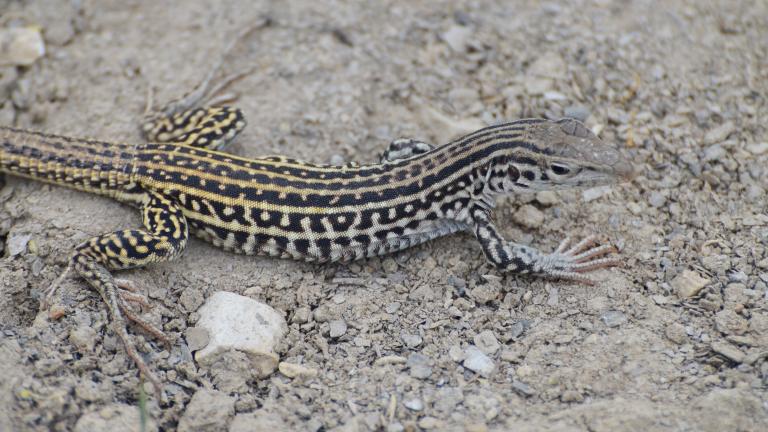New Years Office Closure
Colorado Parks and Wildlife offices will be closed on January 1.
New Years Office Closure
Colorado Parks and Wildlife offices will be closed on January 1.
This all-female species reproduces through a process of "self-cloning", not requiring fertilization of their eggs.

The Colorado checked whiptail is an all-female species that arose from hybridization with other whiptail species. This population of triploid (having three sets of chromosomes instead of the usual two) animals is entirely made up of females, who are able to reproduce parthenogenetically. In parthenogenetic species, reproduction is asexual, and egg cells develop without having been fertilized by male gametes. Consequently, offspring are genetically identical with their mother. Difficult to distinguish from Diploid or Common Checkered Whiptail.
Body and tail long and slender; upper side with small granular scales; belly with larger rectangular scales; scales along front edge of fold of skin across throat conspicuously enlarged. Difficult to distinguish from Diploid Checkered Whiptail. Pale stripes bordering middle of back gray, uninterrupted, straight, often fused with spots; stripe along middle of back gray and, if present on the neck, relatively straight, or stripe on neck followed by spots; lowermost stripe on side of body gray, relatively straight, frequently interrupted by narrow areas of black ground color, usually fused with some spots and/or bars; area between the two uppermost pale stripes (not counting the vertebral line) on each side of the back with linear series of pale spots, some fused with stripes; upper surface of thighs with numerous pale spots often fused into a network; maximum snout-vent length about 10.7 cm (4.2 inches).
Endemic to southeastern Colorado below 7,000 feet. Spotty distribution; locally common, but has declined in some areas as a result of habitat destruction.
Hillsides, arroyos, and canyons associated with the Arkansas River valley; the canyon-grassland transition along the Huerfano River; grassland-surrounded rocky arroyo habitat along tributaries of the Apishapa River; and roadsides, shrubby areas, and juniper-grass associations in valleys, arroyos, and canyons associated with the Purgatoire River and some of its tributaries; a ground dweller, digs burrows used for shelter.
This is an all-female species that arose through hybridization between other whiptail species. Adults produce 1-2 clutches of eggs in June-July. Hatchlings emerge in August, September, or early October.